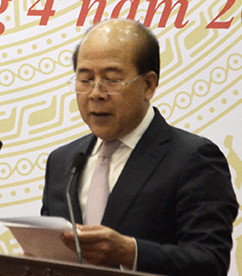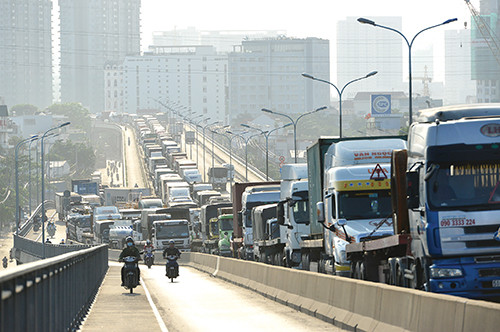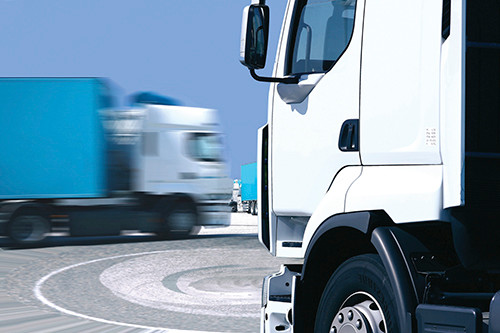Deputy Minister of the minstry of transport Nguyen Van Cong: To cut logistics costs, there are many things to do and it will take much time...
Thời sự - Logistics - Ngày đăng : 11:59, 08/05/2018
(Vietnam Logistics Review) To implement the guidence from the PM Nguyen Xuan Phuc, a national conference on logistics with the theme “solutions to cut costs and to efficiently connect transport infrastructure systems” was hold on april 16th in Hanoi with the Minsitry of transport as a host. VLR had an interview with Deputy Minister (DM) Nguyen Van Cong on current issues in the field of logistics in Vietnam.
 | Deputy Minister (DM) Nguyen Van Cong |
Solutions to cut costs and to connect transport infrastructure system efficiently show the relations between cutting costs and connecting. How is the reality of Vietnam logistics and what are weaknesses of the current transport infrastructure?
DM Nguyen Van Cong: As research and evaluation from World Bank, Vietnam’s Logistics Performance Index in 2016 ranked 64/160 countries; Vietnam’s logistics costs was equally 20.9% of GDP. This is an average number compared to those of developing countries, but high compared to those of developed ones. The numbers in other countries: China. Around 19%; Thailand, around 18%; Japan, around 11% and countries of EU, around 10%.
The transport infrastructure system have been invested and developed. And there have been remarkable changes: many modern and large construction works have been put into operation and have shown their efficiency. World Economic Forum (WEF) delivered a report on competition index of transport infrastructure in the period of 2015 - 2016 carried out in 140 countries. It showed competition index of Vietnam’s transport infrastructure in 2015 - 2016 went up 9 levels, ranking 67 compared to the rank of 76 in 2014 - 2015 and 29 levels, compared to the rank of 96 in 2010 - 2-11. In general, developments of transport infrastructure recently has met the needs of transport for social- economic developments and other purposes.

However, our transport infrastructure systems have not been synchronous enough, and the connectivity is limited, especially in term of connecting among, production centers, consuming centers, and material areas to sea ports, airports, local waterway ports, roads and railroads. There has also been a shortage of assisting service infrastructures. The lack of connectivity is due to the shortage of ICDs and logistics centers of large scale at key economic zones as transshipment hubs, which badly affects transport activities, especially multi-modal transport. This is also a great barrier, a bottleneck to transport activities that heighten transport costs and reduce product competition abilities.
Currently, however there have been investments, road transport infrastructures have not caught up with the growth of transport and connectivity with other transport infrastructures has not been very good.
  |
The railroad’s outdated technology and unsafety - using narrow width railroad - is a limitation. Besides, non-synchronous infrastructures and unable connectivity with seaport system make railroad transport difficult.
Vietnam’s seaport system have been invested to meet demands of import-export stevedoring and local cargo flows as well. However, modern ports of international standards are a few in number. We have a modern international gateway port (Cai Mep- Thi Vai) that enables to receive super large container vessels but shortage of transport infrastructure and one-way navigation way lead to a few number of vessels anchoring at the port and thus it is unable to meet the demand of importexport transport.
Local waterway transport has received little investments. Therefore, its infrastructures (berths, navigation ways, ports), means of transport and stevedoring are outdated. It has been mainly used for bulk cargo only.
How about plans by the Ministry of Transport in the coming time to cut transport logistics cost?
DM Nguyen Van Cong: The Ministry of Transport keeps implementing the Decision no.168/QĐ-TTg by the Prime Minister in approving the Project of Developing Logistics Services in the Field of Transport to 2020, orientation to 2030, especially guidance from the PM in the National Logistics Conference on April 16th and has more focus on these matters:
+ Keep checking and improving legal policies, streamlining business conditions, simplifying administration and special inspection procedures, creating transparent legal environment and healthy competitions to attract various economic sections to take part in doing logistics service business.
+ Checking strategies, plans to develop the logistics sector and investing in transport infrastructures in accordance to strategies and plans of developing industry, agriculture, aquaproduction, import-export and material controls of each region and of national scale as well.
+ Building several key transport corridors to connect production and consuming centers to seaports, identifying key cargo (in term of quantity or high value), finding optimal transport manner and investing in them for a purpose: a supply chain for shippers is a multi-modal supply chain and the relationship among various means of transport should be improved to ensure efficiency and cost-cutting.

+ Building local waterway transport infrastructures (berths, ports and navigation ways) at some key zones with State budget and socialized ones should be put in priority, together with modernizing means of local waterway transport, stevedoring equipment. Investing in or upgrading bridges and railroads bridges to improving both horizontal and vertical clearance with the purpose of making good use of the advantages of local waterway transport: less investments, low transport costs, green developments.
 Logistics is a progress of optimizing any work from the stages of supply, production, delivery of goods and consuming goods so it is related to and affected by ministries, sectors, local authorities, organization and individuals.  |
+ Upgrading the navigation way to Cai Mep- Thi Vai for super large container vessels, which attracts liners to have more routes to Cai Mep- Thi Vai, making it gradually become a regional international transshipment port.
+ Working with local authorities to develop the Detail Plan of Developing Vietnam’s ICDs to 2020, orientation to 2030. Having guidance and facilitating private organizations to build ICD system in accordance to the plans. ICD development will help container transport, increasing efficiency of logistics services on transport corridors and reducing congestions at seaports, international gateways and large cities.
+ Researching and building a mechanism for reasonable container service price for transparent business activities at ports, for avoiding unfair competitions and for efficient business, which enables re-investments for better stevedoring equipment, storage system…
+ Keep researching and reporting to the Government and the PM to approve applying advanced models of managements, construction and exploitation at international gateway ports with logistics zones behind. They should be large enough to develop industrial and commercial zones to receive materials and to produce goods on site to save time and transport costs.
To reduce logistics costs and to improve competitions abilities of Vietnamese goods, it is not the job for the Ministry of Transport only. What do you think about the matter?
DM Nguyen Van Cong: Right, logistics is not a single service but a chain of service system. Logistics is a progress of optimizing any work from the stages of supply, production, delivery of goods and consuming goods so it is related to and affected by ministries, sectors, local authorities, organization and individuals.
As in other countries in the world, transport cost always accounts for a large proportion in total logistics costs. In Vietnam, it is around 59%- 60%; in the U.S, 63%; in Thailand, around 53.5%; in China, 53.3%. Therefore, reducing transport cost plays an important roles in reducing logistics costs.

However, to cut transport cost, we need large resources to invest in synchronous connecting transport system… and it takes time. However, innovations in policies and mechanisms (facilitating business conditions, simplifying administrative procedures and inspection procedures…) and upgrading quality are what we can do at once.
To cut logistics cost, on one hand, the Ministry of Transport will actively implement above solutions. On the other hand, the Ministry will have cooperation with the Ministry of Industry-Trade, the Ministry of Finance, the Ministry of Plan and Investments, and other Ministries, sectors, related organizations and local authorities for policy innovations, for implementing plans and strategies of social- economic developments:
+ Simplifying administrative policies and specialized inspection procedures in accordance to international standards, implementing e-customs and one-stop customs mechanism.
+ Encouraging connectivity among Vietnam logistics enterprises and among logistics enterprises to import-export ones, industrial parks and producers as well.
+ Improving quality of human resources. Focusing on university training and vocational training for the logistics sector. Improving education quality, especially in term of value chain managements, which help business managers to take advantages of opportunities and professionalizing logistics services.
+ Improving abilities and service quality of logistics enterprises.
+ Developing a transparent, efficient logistics market.
Thank you, Mr. Deputy Minister.
